
 |
|
|
#1 |
|
All the news that's fit to excerpt
Name: newsie
Location: who knows?
Join Date: Jun 2008 Motorcycle(s): only digital replicas Posts: Too much.
|
[motorcycle.com] - 2016 Honda RC213V-S First Ride Review
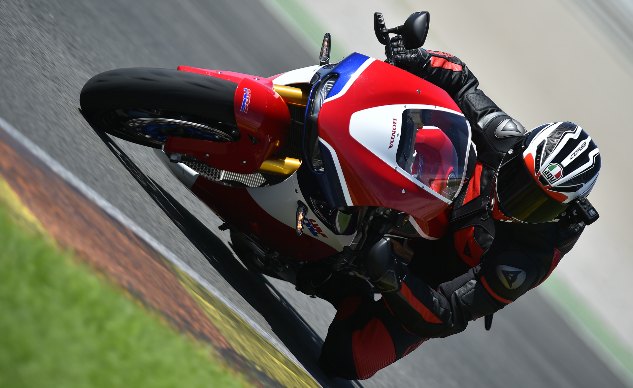 Hard braking into a corner, rear wheel skipping across the pavement trying to come around one side or the other, release a little brake pressure, tip it in, pass a couple riders before the apex then begin accelerating toward the next corner. I didnít do this during the press intro for the Honda RC213V-S at the Ricardo Tormo circuit in Valencia Spain, but having now piloted a bike similar to the one Marc Marquez rides in the heat of MotoGP combat provides insight into how the two-time Grand Prix champ manages to make the impossible seem like childís play. Prior to our ride day, Honda compelled us to understand that the entire purpose of the RC213V is not to have the fastest MotoGP bike in the paddock, but for it to be the most rideable one. This philosophy was applied to the S model in a way that doesnít replicate the race bikeís absolute power but rather recreates the riding experience through exceptional maneuverability. In other words, Honda thinks the RC213V-S is the ultimate expression of sportbike handling and is betting deep-pocketed enthusiasts are willing to pay $184,000 for the pleasure of experiencing motorcycle performance previously only available to a chosen few.  Like the race bikes, the RC213V-S is hand-built at the Kumamoto factory by a dedicated team of specially trained employees. Most components Ė frame, swingarm, pistons, engine block, etc. Ė* are direct descendants of the MotoGP machine. The S model does not have the seamless transmission or pneumatic valves of the factory bike, but it does have the same camshaft gear train of the RCV1000R Open Class racer. Like the race bikes, the RC213V-S is hand-built at the Kumamoto factory by a dedicated team of specially trained employees. Most components Ė frame, swingarm, pistons, engine block, etc. Ė* are direct descendants of the MotoGP machine. The S model does not have the seamless transmission or pneumatic valves of the factory bike, but it does have the same camshaft gear train of the RCV1000R Open Class racer.The Honda GP bike referred to as the RC213(two-thirteen)V is actually the RC twenty-one three V, the numeric nomenclature signifying that the bike is of the 21st century and the current model being the 3rd iteration (this was news to everyone in attendance at the media event, even American Honda employees). The first version was the 990cc V5-cylinder RC211V and the second the 800cc RC212V. But Honda never offered street-legal versions of those two bikes. In fact, never before in the history of modern grand prix racing has Honda brought to market a motorcycle directly from HRC. The 1992 NR750 comes close, but that was more of an exercise in engineering bravado rather than the distilled performance of the RC213V-S. We thoroughly covered the specifications of the RC213V-S when the bike officially broke cover June 11th, then followed that report with an in-the-flesh unveiling from John Burns during the Catalunya Grand Prix. Since then thereís been nothing but speculation regarding whether or not the RCV-Sís value equals its MSRP. Can it really be worth $184k? Is it actually $165k better than the MotoGP-for-the-street Yamaha R1M, Aprilia RSV4 RF, BMW S1000RR or Ducati 1299 Panigale? 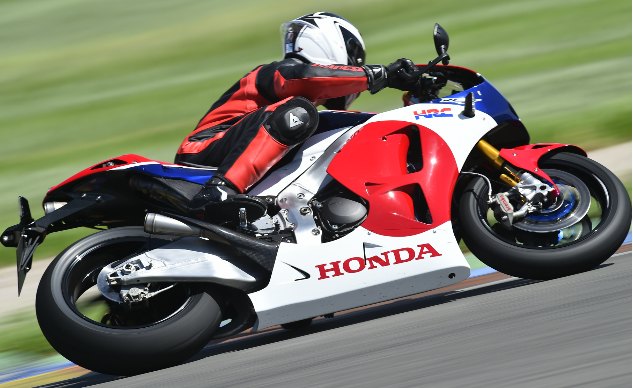 Ownership is a small club. Upwards of only 250 RC213V-Ss will be constructed (wouldnít 213 be a more appropriate figure?). European customers will be first served, U.S. availability was yet undetermined. Standard versions come shod with Bridgestone RS10s, which performed well at track speeds but certainly gave the Hondaís Selectable Torque Control (HSTC) Ė*Honda speak for traction control Ė*a workout. Ownership is a small club. Upwards of only 250 RC213V-Ss will be constructed (wouldnít 213 be a more appropriate figure?). European customers will be first served, U.S. availability was yet undetermined. Standard versions come shod with Bridgestone RS10s, which performed well at track speeds but certainly gave the Hondaís Selectable Torque Control (HSTC) Ė*Honda speak for traction control Ė*a workout.Then of course thereís the unavoidable elephant in the room; the U.S. versionís electronically neutered 101 horsepower RC213V-S Ė a bike costing approximately the same* as the* European version that puts out 157 horsepower in stock trim Ė one that can be outfitted with the race kit, bumping hp to a robust 212. Seems as though the U.S. is getting the raw end of the deal until you learn the RCV-S in its country of origin produces a mere 68 horsepower.* I framed this question to Honda, asking why the same bike lacking 55 horsepower wasn’t deserving a price reduction. The reply I got is the RCV-S does not generate its value based on horsepower because the horsepower potential is the same for all RCV-Sís regardless of their manufactured state of tune. But Honda isnít making the race kit available stateside, leaving American RCV-Sís $184,000 worth of untapped potential. 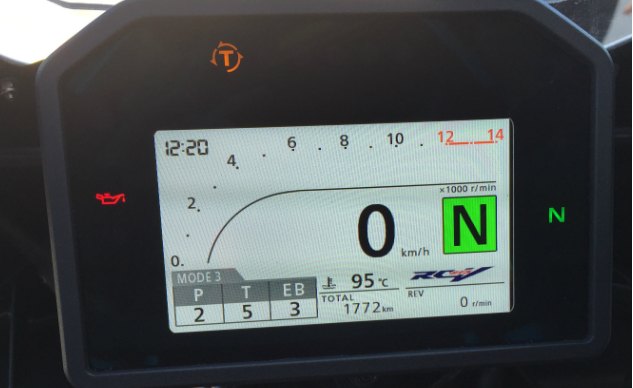 The full-color display has five preset modes. Within each, the settings can be customized for Power 1-3, HSTC 1-10, Engine Braking 1-4. Street mode (pictured) displays speed, while circuit mode displays lap times and a lap counter. Installing the race kit ECU changes the tachometer so that RPMs begin at 2,000 and redline at 14,000. The full-color display has five preset modes. Within each, the settings can be customized for Power 1-3, HSTC 1-10, Engine Braking 1-4. Street mode (pictured) displays speed, while circuit mode displays lap times and a lap counter. Installing the race kit ECU changes the tachometer so that RPMs begin at 2,000 and redline at 14,000.What Iíve come to terms with is the person who can afford a $184k motorcycle can also afford to find a way to circumvent Hondaís stonewalling and unlock the full potential of the RCV-S. Having now ridden the Euro spec RC213V-S and its race-kitted counterpart, Iíve also come to understand that horsepower Ė although important Ė plays somewhat of a sideshow to the bikeís magic-carpet-ride experience. Sure, would I have been less thrilled to be testing the 101-horsepower model coming stateside instead of the Euro-spec model and race-kitted versions? Absolutely. But even if that had been the case Iíd still have come away from the test with a look behind the curtain of how good a MotoGP bike can be.  Engine output according to power mode. Engine output according to power mode.Every component on the RC213V-S is composed to work as fluidly as possible, not just as an independent function but as a package. The S model isnít equipped with Hondaís secret seamless transmission, but the attention to detail in the drivetrain is felt in the perfect engagement of the of the quick-shifter grabbing a higher gear in the cassette transmission, the light action of the dry clutch felt at the lever, and the ability of the slipper assist to mask any interference after dropping three gears and dumping the clutch upon entering a fast sweeper. Performing in conjunction with the RCV-Sís arsenal of electronic technology makes for the most technologically advanced street-legal Honda sportbike to date. Itís not until you put the Honda on its side, though, that you begin to appreciate how confidence-inspiring the RCV-S really is. Never before has the term mass-centralization meant as much as when applying the phrase to RC213V-S. The bikeís ability to cope with any hard-braking or cornering situation is well above the skills of most mortal riders. The RCV-S inspires so much confidence you feel as if grand prix road racing may have been your true calling. Upon further reflection you realize youíre barely scratching the surface of a motorcycle with such depth of performance youíll never mine the entirety of its potential. 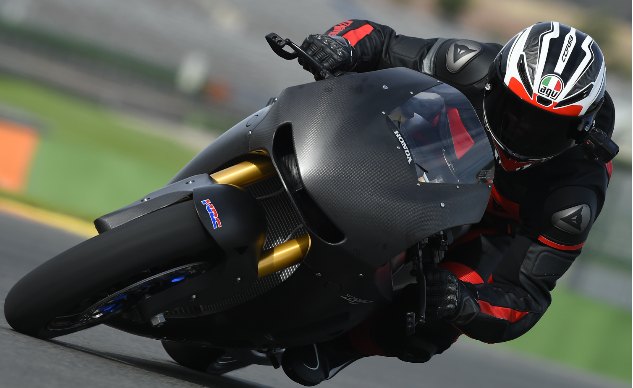 The street bike RCV-S is good, but things got way more interesting when Honda cut us loose on the race-kitted version. Gone is the headlight and in its place a ram-air duct. The titanium exhaust system roars with full MotoGP effect increasing the Marquez daydream. Altogether, the race-kitted bike is about 22 pounds lighter and produces a claimed 212 crank horsepower. The street bike RCV-S is good, but things got way more interesting when Honda cut us loose on the race-kitted version. Gone is the headlight and in its place a ram-air duct. The titanium exhaust system roars with full MotoGP effect increasing the Marquez daydream. Altogether, the race-kitted bike is about 22 pounds lighter and produces a claimed 212 crank horsepower.The closest production superbike emulating the RCV-Sís handling characteristics is the Aprilia RSV4 RF, but even this bike (one of MOís favorites in terms of handling) is a step behind the Honda. Certainly the RCV-S has a weight advantage (claimed dry weight of 379 pounds), but itís also a matter of the chassis package comprising the RC213V-S. Many of the same components used on the GP bike have been carried over to the S model including the forged Marchesini magnesium wheels (slightly thicker to increase durability), Brembo front and rear brake calipers and master cylinder, and Ohlins TTX25 fork and Ohlins TTX36 shock (based on MotoGP bikeís specifications); these all conspire to elevate the handling performance of the RCV-S to a level of transcendence. 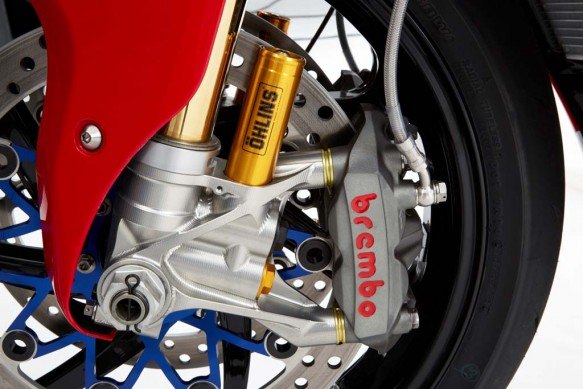 Former Grand Prix racer and current Honda development rider, Shinichi Ito, was in attendance to lead our first few laps around the Ricardo Tormo circuit. I assumed he had arrived in advance and set the suspension to perform best around the tight and twisty track. Surprise is an understatement when after a few sessions I discovered both the street bike and race-kitted versions were running stock suspension settings. The Brembo brake components are the same as used on the MotoGP bike minus the carbon brake discs. Former Grand Prix racer and current Honda development rider, Shinichi Ito, was in attendance to lead our first few laps around the Ricardo Tormo circuit. I assumed he had arrived in advance and set the suspension to perform best around the tight and twisty track. Surprise is an understatement when after a few sessions I discovered both the street bike and race-kitted versions were running stock suspension settings. The Brembo brake components are the same as used on the MotoGP bike minus the carbon brake discs.Honda chose the twisty Valencia track to highlight the agility and handling attributes of* RC213V-S, but I couldnít help but wonder what itíd be like to hustle the RCV-S down one of my favorite, super-tight set of SoCal switchbacks. At the track, however, the RCV-S doesnít chastise the pace youíre setting or complain about ham-fisted movements but rather willingly complies with the speed of travel and rider inputs in the most unassuming a way a motorcycle of this caliber can. From the first lap onward, the biggest aspect demanding my attention is when we switched from the normal shifting pattern of the street machine to the reverse-shift pattern of the race-kitted model.* Both bikes are outfitted with quick-shifters, but where the base model RCV-S uses a switch-type function, the race kit replaces it with a load-cell one. Both versions worked flawlessly during our track testing, but neither system includes an auto-blipping downshift function. 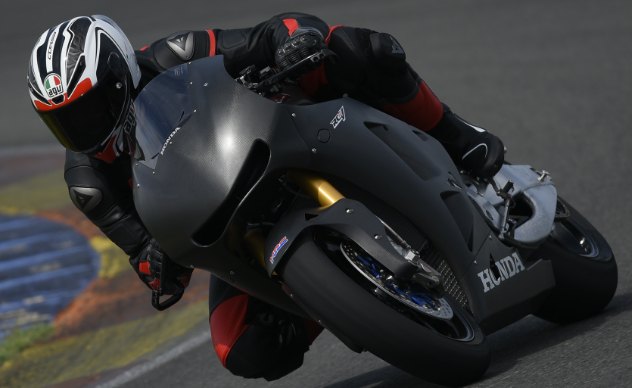 Colin Edwards once said his YZR-M1 was an easier bike to ride than the YZF-R1 at the time. That analogy applies here in the aspect that the RC213V-S is easier to ride fast than other production superbikes on the market. Honda says the dry clutch in the RC213V-S should be serviced every 2,000 miles. Cost of ownership also comes with a price tag. Colin Edwards once said his YZR-M1 was an easier bike to ride than the YZF-R1 at the time. That analogy applies here in the aspect that the RC213V-S is easier to ride fast than other production superbikes on the market. Honda says the dry clutch in the RC213V-S should be serviced every 2,000 miles. Cost of ownership also comes with a price tag.Engine characteristics between the two models, however, remain similar, with the V-Four engine willingly, quickly, excitingly revving to its redline with incredibly linear power outputs. Of course the RCV-Sís electronics are working in the background, but power is easily manageable with the ride-by-wire throttle. Those already familiar with Honda V-Fours and their power delivery know, to some degree, what to expect from this engine. Itís deceptively fast without feeling like itís that fast. A BMW S1000RR with similar rear-wheel horsepower may actually feel more potent.* The riding position is also derived from the MotoGP machine and, as such, is unforgiving in terms of streetable comfort. This isnít a concern on the track, but as Honda keeps telling us, this is meant to be a street experience. Ironically, as much as Honda kept mentioning this fact, Honda admitted to never having tested the RCV-S on the street, and the press launch was a track-only affair where Honda asked the attending journalists to ride the Euro-spec street model in the same way we would had we been on public roads. As ifÖ 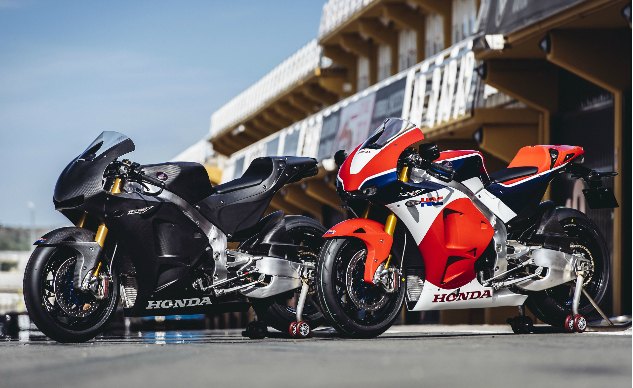 The RC213V-S is available in the tricolor design or unpainted carbon fiber. For those willing to afford this bike the idea of a few thousand more for a custom paint job is but a drop in the financial bucket. The RC213V-S is available in the tricolor design or unpainted carbon fiber. For those willing to afford this bike the idea of a few thousand more for a custom paint job is but a drop in the financial bucket.After having spent a day aboard the RC213V-S, and if we were to pretend I could actually afford one, was I convinced itís value is worthy of the price tag? Yes. Not only is it a sublime motorcycle in every sense of motorcycle performance, itís also something so unique and rare it could command an even greater retail value, and most likely will over the coming years. Like similar predecessors from Honda (RC30, RC45, NR750), the RC213V-S represents another benchmark motorcycle thatís unlike anything currently available.* Sure, it can be argued that if itís a streetbike, whereís the ABS and C-ABS? For the price, how come thereís no auto-blipping downshift function on the quickshifter? Youíd be right for asking these questions, and the easy solution is the affordable availability of production superbikes that have these technologies. But like a $50k wristwatch that doesnít keep time any better than a $50 wristwatch, there exists a relative value to individuals who can afford such hardware. 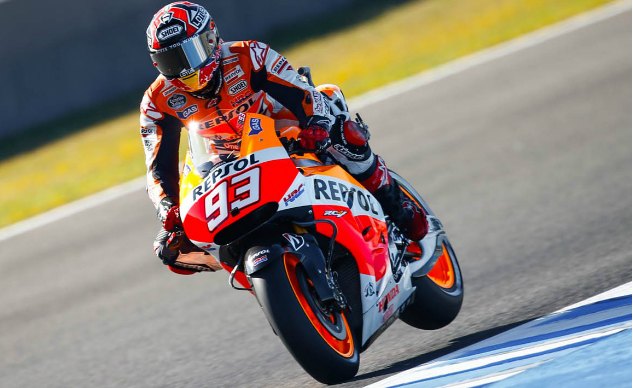 The RC213V-S is out reach for most of us, but the next time you see Marquez entering a corner all crossed-up, seemingly on the knifeís edge of crashing, only to flick his RC213V into a 60-degree lean angle and two-wheel power slide, keep in mind that the bike heís aboard is a rolling encouragement built to emphasize his otherworldly riding skills. And for those who can afford the street-legal version of Marquezís e-ticket ride, donít hesitate. Hondaís only taking orders until September 30 of this year, and then the opportunity ceases to exist.* 2016 Honda RC213V-S First Ride Review appeared first on Motorcycle.com. Click here for full story...
__________________________________________________
I'm a bot. I don't need no stinkin' signature... |
|
|

|
 |
 Similar Threads
Similar Threads
|
||||
| Thread | Thread Starter | Forum | Replies | Last Post |
| [motorcycle.com] - 2016 Honda CRF450R First Ride Review | Ninjette Newsbot | Motorcycling News | 0 | July 23rd, 2015 12:40 PM |
| [motorcycle.com] - In the Flesh: 2016 Honda RC213V-S Up Close | Ninjette Newsbot | Motorcycling News | 0 | June 12th, 2015 11:50 AM |
| [motorcycle-usa.com] - Honda RC213V-S Set For Production in 2016 | Ninjette Newsbot | Motorcycling News | 0 | June 11th, 2015 02:40 PM |
| [superbikeplanet.com] - 2016 Honda RC213V-S Images | Ninjette Newsbot | Motorcycling News | 0 | June 11th, 2015 09:40 AM |
| [superbikeplanet.com] - Honda Confirms RC213V-S for 2016 | Ninjette Newsbot | Motorcycling News | 0 | June 11th, 2015 06:40 AM |
|
|